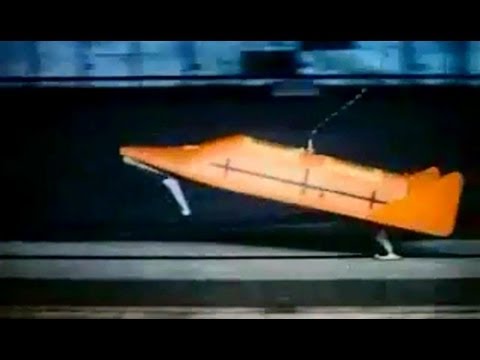more at
“Landing characteristics were investigated using dynamic models. The landing speeds for several let-down systems are simulated. Demonstrations include: (1) the vertical landing of parachute-supported capsules on water; (2) reduction of landing acceleration by shaping the impact surface for water entry; (3) problems created by horizontal velocity due to wind; (4) the use of energy absorbers (yielding metal legs or torus bags) for land or water landings; (5) problems associated with horizontal land landings; (6) the use of a paraglider to aid in vehicle direction control; (7) a curved under-surface to serve as a skid-rocker to convert sinking-speed energy into angular energy; (8) horizontal-type landing obtained with winged vehicles on a hard runway; (9) the dangers of high-speed water landings; and (10) the positive effects of parachute support for landing winged vehicles.” Silent.
Public domain film from NASA, slightly cropped to remove uneven edges, with the aspect ratio corrected, and mild video noise reduction applied.
Splashdown is the method of landing a spacecraft by parachute in a body of water. It was used by American manned spacecraft prior to the Space Shuttle program…
As the name suggests, the capsule parachutes into an ocean or other large body of water…
The splashdown method of landing was utilized for Mercury, Gemini and Apollo (including Skylab, which used Apollo capsules)…
On early Mercury flights, a helicopter attached a cable to the capsule, lifted it from the water and delivered it to a nearby ship. This was changed after the sinking of Liberty Bell 7. All later Mercury, Gemini and Apollo capsules had a flotation collar (similar to a rubber life raft) attached to the spacecraft to increase their buoyancy. The spacecraft would then be brought alongside a ship and lifted onto deck by crane…
The early design concept for the new U.S. Orion Crew Exploration Vehicle featured recovery on land using a combination of parachutes and airbags, although it was also designed to make a contingency splashdown (only for an in-flight abort) if needed. Due to weight considerations, the airbag design concept was dropped. The present design concept features landings via splashdown in the Pacific Ocean off the coast of California…
Landing Energy Dissipation for Manned Reentry Vehicles
Technical Note D-453 1960
…Water impact.- Another method for landing a space capsule is the
water landing… The water
landing provides a way of obtaining long stroke without onboard devices,
that is, by shaping the vehicle for water penetration. It is also of
interest where accuracy for hitting a landing area is a question… The curves show that configuration
shape has a significant influence on landing acceleration.
At 0 ° contact attitude the 126-inch spherical radius model has a blunt
shape, water penetration is small, and the peak acceleration is high.
Onset rate is about 20,000 g/sec. As contact attitude changes from
0 °, the accelerations decrease rapidly and onset rate also decreases
to about 800 g/sec at a 30 ° contact attitude. The difference is due to
the more pointed shape of the impacting surface as attitude increases.
The 53 ° conical model has fairly low accelerations, about 10g, and
shows little change with change in attitude. Onset rate is about
400 g/sec. The accelerations in the 10g region for both models result
from fairly deep water penetration or in other words relatively long
strokes…
…It appears feasible to readily evaluate landing-gear systems for
internal or external application in hard-surface or water landings by
computation methods and free-body landing techniques with dynamic models.
The systems investigated have shown very interesting landing-energy dissipation
characteristics over a considerable range of landing parameters.
Acceptable gear could be developed along lines similar to those
presented if stroke requirements and human-tolerance limits are
considered.

